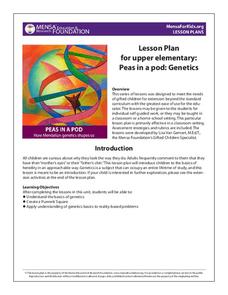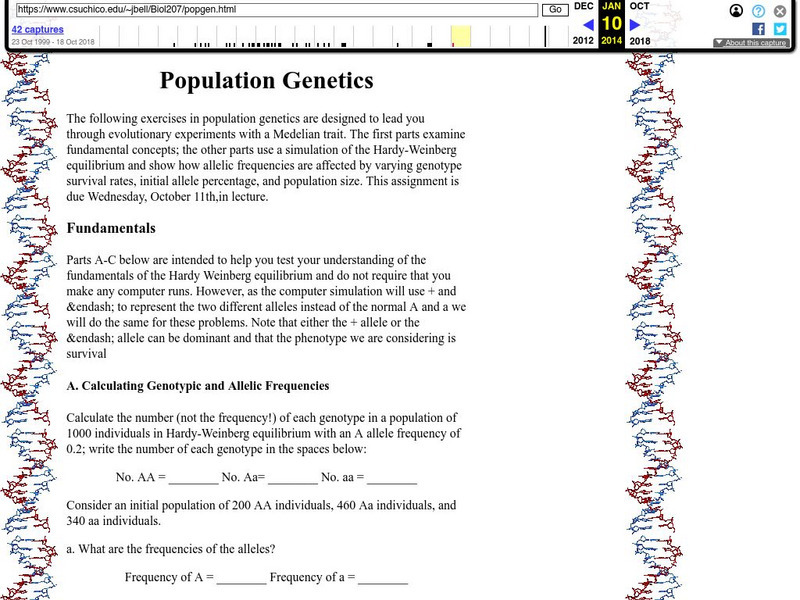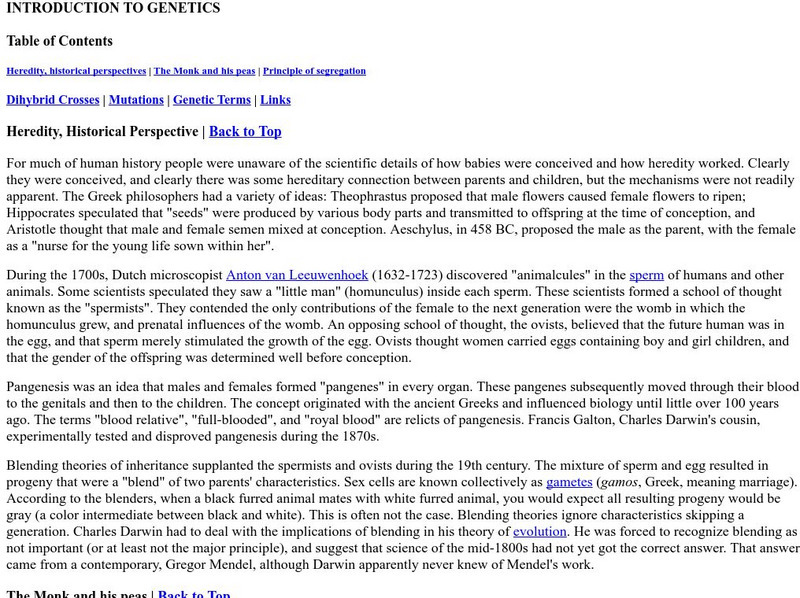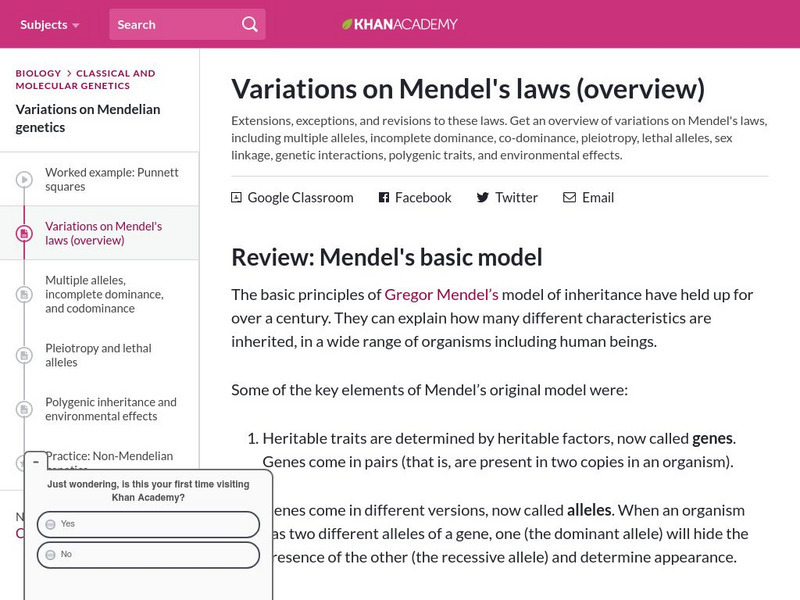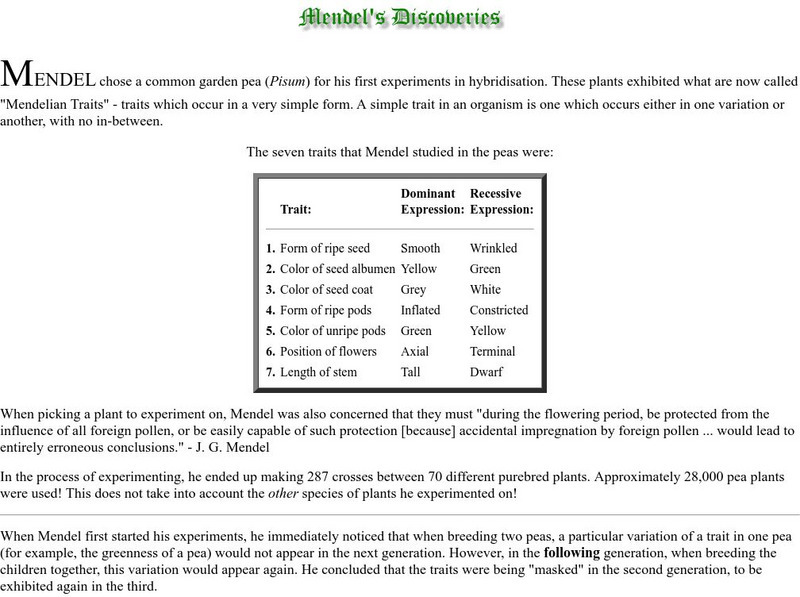MENSA Education & Research Foundation
Peas in a Pod: Genetics
Can peas have grandparents? Learn about inherited traits and heredity with a set of activities focused on Mendelian genetics. As your class learns about the process of passing traits along in Punnett squares, they take on the role of...
Towson University
Mystery of the Crooked Cell
Can your class solve the Mystery of the Crooked Cell? Junior geneticists collaborate to learn about sickle cell anemia in a fascinating lesson plan. The included materials help them to examine the genetic factors behind the disease...
Towson University
Mystery Disease
How did scientists determine the cause of illness before technology? Science scholars play the role of medical researcher in an engaging guided inquiry activity. Using observations, technical reading, and Punnett squares, learners...
eSchool Today
E School Today: Your Cool Tips on Genetics
Explains basic genetics concepts, including genes, DNA, chromosomes, sex chromosomes, how traits are inherited, genetic variation, cloning, and stem cells.
California State University
Csu Chico: Population Genetics
This is a group of Mendelian Genetics exercises that are designed to show the evolution of a trait within a population. The site covers instruction in calculating genotypic and allelic frequencies, determining dominance, the...
CPALMS
Florida State University Cpalms: Florida Students: Complex Modes of Inheritance
A tutorial reviews polygenic and multiple alleles, Punnett Square, sex-linked trait, and inheritance patterns. Follow the slides to ensure comprehension of inheritance.
Palomar Community College District
Palomar College: Mendels' Genetics
This site from Palomar College provides a good background on exactly what Mendel did. Vocabulary links throughout make this a very good introduction article for genetics.
Estrella Mountain Community College
Estrella Mountian College: Introduction to Genetics
This site explains genetic beliefs before and after Mendel, and also includes a section on Mendel himself and his experiments, entitled, "The Monk and his Peas".
Oak Ridge National Laboratory
Oak Ridge National Laboratory: Behavioral Genetics
A useful introduction from the Oak Ridge National Laboratory on the study of how genetics and behavior are linked. Many useful resource links are included.
Other
Suny: Biology: Pedigree Analysis
Pedigree inheritance is a method of examining inherited traits. Learn how to use this method and develop conclusions through these examples.
Estrella Mountain Community College
Online Biology Book: Introduction to Genetics
This college-level biology reference book introduces the study of heredity and genetics using diagrams and descriptive illustrations.
Palomar Community College District
Waynes Word: Multiple Gene (Polygenic) Inheritance
Explains and gives examples of polygenic inheritance.
University of Hamburg
University of Hamburg: Deviations From Mendelian Laws And: What Is the Meaning of Dominance?
Upper level discussion of several of Mendel's experiments and laws.
Treehut
Suzy's World: Genetics Why Do You Look Like You?
This site explores the role genetics plays in making you look the way that you do. Content includes fun facts and a classroom experiment.
CK-12 Foundation
Ck 12: Biology: Mendelian Inheritance Study Guide
Review the processes of basic Mendelian genetics.
Khan Academy
Khan Academy: Variations on Mendel's Laws (Overview)
Article reviews Mendel's basic model of inheritance then provides an overview of variations on Mendel's laws, including multiple alleles, incomplete dominance, co-dominance, pleiotropy, lethal alleles, sex linkage, genetic interactions,...
Other
Lawrence Livermore National Lab: Probabilities of Traits
This site explains how to determine the chances of inheriting certain traits from our parents. It gives mathematical examples and exercises.
Other
Human Genetics Multifactorial Inheritance
On this University of Illinois at Chicago site you can get the importance of multifactorial inheritance, and numerous models to help illustrate the idea. There is a summary at the bottom for review, and an address to send questions to...
Other
North Dakota State Univ.: Mendel's Law of Ind. Assort.
Mendel's second law and how he arrived at it through his experiments. Includes vocabulary and examples.
Other
Personal Site / Mendels Discoveries
This personal site gives the seven characteristics that Mendel observed and a fairly large background to what Mendel saw and interpreted.
University of Utah
University of Utah: learn.genetics: Ptc: The Genetics of Bitter Taste
Read about the PTC gene, and listen to scientists discuss this accidental discovery which lead to important clues about human evolution.
Other
Your Doctor: Sickle Cell Anemia (In Arabic)
Photos of slides and genetics charts accompany the text and explain the differences between sickle cell train vs. sickle cell anemia, symptoms of sickle cell disease, secondary diseases/conditions associated with sickle cell, mechanism...
Sophia Learning
Sophia: X Linked Traits
This lesson will give examples of disorders that are linked to genes on the X chromosome.
University of Utah
University of Utah: Learning Center: The Epigenome Learns From Its Experiences
Find out how epigenetic tags that tell genes whether to turn on or off in their lifetime, act as a cellular memory.
